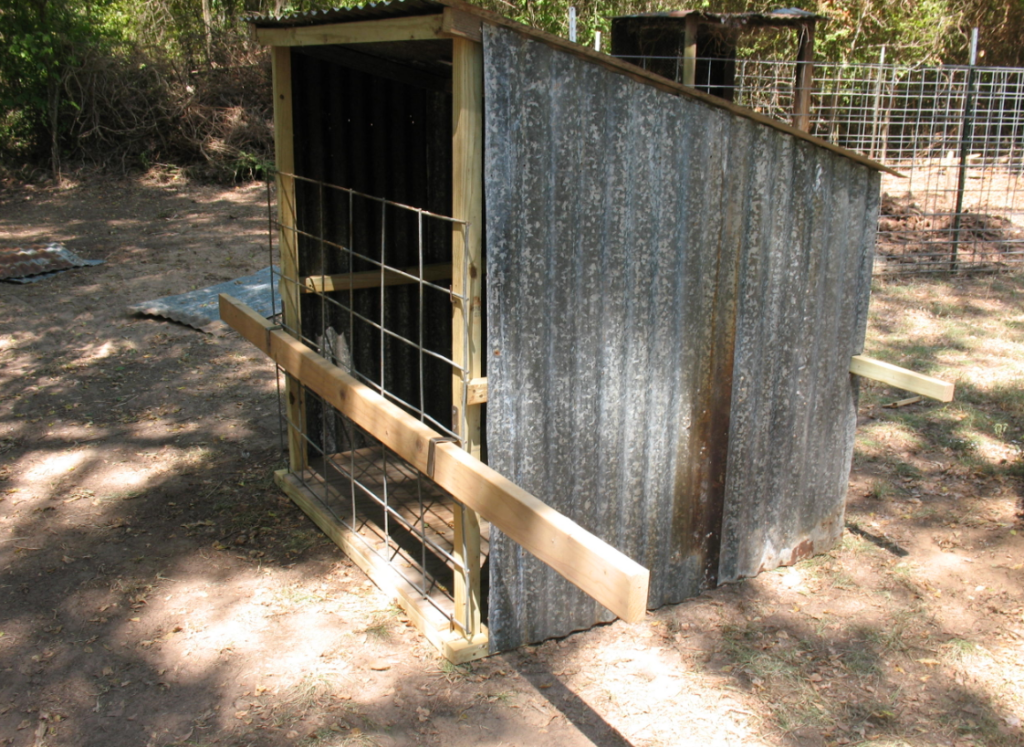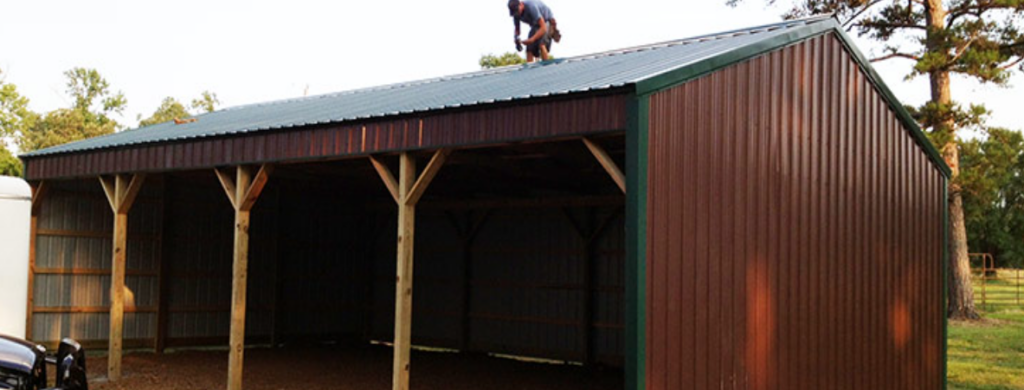Looking for smart ways to keep your goats safe, dry, and comfortable all year? These DIY goat shelter ideas are perfect for anyone wanting to create a functional setup without spending a fortune. Goats don’t need anything fancy—just a sturdy, well-ventilated spot that shields them from wind, rain, and harsh sun.
With a little creativity and some basic tools, you can build shelters that suit your space and style. Think simple A-frames, pallet barns, or even upcycled playhouses. These practical ideas are great for small farms, backyard homesteads, or anyone getting started with goat care on a budget.
1. Pallet Goat Shelter
Using wood pallets to build a goat shelter is not only budget-friendly but also incredibly satisfying for anyone who loves a good DIY challenge. These shelters come together quickly, using commonly found materials that would otherwise go to waste. With a few nails, some screws, and a bit of creativity, you can piece together strong, rustic walls that offer your goats a cozy, secure space. The gaps in the pallet design also provide a bit of natural airflow, helping to keep things cool during warmer months.
What makes this idea shine is its sustainability and flexibility. You can scale it up or down depending on your herd size, add a sloped roof for rain runoff, and even insulate the interior for winter. Plus, you can often get pallets for free from local businesses—making this one of the most cost-effective and eco-conscious ways to house your goats.

2. Hoop House Goat Shelter
Forget traditional barn vibes—hoop house shelters are like the cool, modern cousin of the goat housing world. Built with curved PVC pipes or metal hoops and wrapped in heavy-duty tarp or greenhouse plastic, they’re incredibly lightweight and easy to assemble. Don’t be fooled by the simple setup, though; they’re tough enough to withstand wind and rain when anchored properly.
This type of shelter is perfect for anyone needing a quick, weather-resistant option that doesn’t require carpentry skills. The rounded shape naturally sheds snow and rain, keeping the inside dry. Add straw on the ground for comfort and you’ve got a warm, wind-resistant space that goats actually enjoy lounging in. Plus, it looks kind of adorable nestled on a pasture, like a little hobbit home for your herd.

3. A-Frame Goat Shed
There’s something timeless and charming about the shape of an A-frame shed. It’s one of those designs that just makes sense: simple to build, yet effective. The steep pitch of the roof ensures rain and snow slide right off, and the triangular structure feels snug and secure for goats. You can use plywood, metal sheeting, or even repurposed boards depending on what’s available.
What sets this style apart is how space-efficient it is. The compact footprint is great for smaller yards or rotational grazing setups. It’s also a favorite for people who want a shelter that doubles as a visual feature on the property—clean lines and practical function wrapped in one. Add a hinged door and maybe a small window, and your goats will be living in a structure that’s both cute and cleverly designed.

4. Lean-To Goat Shelter
Sometimes, simplicity wins, and that’s exactly why the lean-to goat shelter has stuck around as a tried-and-true option. Built by attaching a slanted roof to an existing wall or post structure, it requires minimal materials and even less effort to put together. It’s especially handy if you already have a barn, garage, or fence line to build against.
Not only is this shelter space-saving, it’s great for quick coverage when storms roll in or the temperature drops. You can toss in a bale of straw, tack up a windbreak on the open side, and your goats are good to go. It’s also really easy to clean and maintain, which is a big win when your days are already full of chores. For anyone just getting started with goats, this one’s a solid and straightforward pick.

5. Recycled Shed Goat House
Turning an old shed into a goat house is a genius way to give something new life. Instead of tearing it down or leaving it unused, you can retrofit it with a few key updates like extra ventilation, a goat-sized doorway, and interior bedding. Most sheds are already weatherproof, so you’re halfway there before you even start.
This idea is all about repurposing with purpose. You’re saving money, reducing waste, and providing your goats with a solid, roomy space to call home. With a few shelves removed and maybe a fresh coat of paint, it can feel brand new—without the price tag of building something from scratch. Plus, goats love exploring quirky spaces, and a recycled shed adds character to your setup.

6. Goat Shelter with Storage Loft
When you need more than just shelter, a design with a built-in storage loft really comes in handy. Picture this: goats snoozing safely below while hay, tools, and supplies stay dry and organized above. It’s a compact but highly functional structure, making great use of vertical space without expanding the footprint.
The real beauty of this shelter is its efficiency. No more trudging to the barn or garage for feed—everything is right there. You can build it with wood framing and a gabled roof to support the upper loft, and maybe even install a small ladder or pulley system for lifting items. It’s a smart choice for small farms where space and convenience matter equally.

7. Portable Goat Shelter on Skids
If you like flexibility, this mobile goat shelter is a game-changer. Built on skids, it can be pulled or pushed to wherever your herd needs it. That means better pasture rotation, less mud buildup, and fresh grazing areas without needing to build a shelter in every paddock. It’s usually lightweight, with a simple wooden frame and metal or tarp roof.
Mobility is the star feature here, but it’s also surprisingly durable and practical. Many folks attach ropes or chains for easy dragging with a tractor or ATV. And since it’s off the ground, drainage isn’t an issue. Whether you’ve got a large pasture or just want to keep things neat, a portable option like this offers freedom and convenience all in one.

8. Three-Sided Pole Barn Shelter
A three-sided pole barn is like the open-concept loft of goat shelters—sturdy, breezy, and easy to build. With a roof overhead and three protective walls, it offers just the right mix of coverage and airflow. This type of shelter works especially well in mild climates or areas where you want your goats to have plenty of ventilation without being fully enclosed.
The best part? It’s low maintenance and scalable. Whether you’re housing a handful of goats or a larger herd, you can adjust the size and materials to suit your needs. Use treated wood posts, metal roofing, and even add a gate across the front if predators are a concern. It’s straightforward, practical, and gives your goats plenty of room to hang out.

9. Elevated Goat House with Ramp
An elevated shelter brings a little flair—and a lot of functionality—to your goat housing. Raised up on sturdy legs, it stays dry even during rainy seasons and deters pests like rodents from setting up shop. A gently sloped ramp gives your goats easy access, and they’ll love the height for play and lounging.
It’s a smart solution for wetter areas or uneven ground, and it adds a fun treehouse vibe to your goat setup. You can build it from plywood and lumber, and design the ramp with traction strips or slats for better grip. Not only does it protect your herd, but it also gives them a space they’ll genuinely enjoy climbing in and out of every day.

10. Simple Tarp and Frame Shelter
When you’re in a pinch or on a tight budget, a tarp and frame shelter can be a real lifesaver. Built with just a few posts or PVC pipes and a tough tarp, this structure comes together quickly and provides instant shade and rain protection. It’s lightweight and great for temporary use or seasonal coverage.
Despite its humble appearance, it’s actually a versatile and useful option. You can set it up in an afternoon, move it around as needed, and adjust the size based on how many goats you’re housing. While it might not stand up to a blizzard, it’s perfect for summer shade, travel setups, or backup shelter in unpredictable weather. Simple doesn’t mean ineffective—and this idea proves it.

FAQs
1. What size should a goat shelter be?
Goats don’t need a mansion, but they do like a little elbow room. A good rule of thumb is 10 to 15 square feet per goat inside the shelter, and more space outside if possible. If you’ve got larger breeds, aim for the higher end. Also, keep the ceiling high enough for you to walk in—your back will thank you.
2. Do goats need insulation or heating in their shelter?
Not usually! Goats are surprisingly tough. As long as they’re dry and out of the wind, they’re good to go. In colder climates, you can add straw bedding for warmth, and make sure the shelter blocks wind and snow. Avoid heat lamps unless absolutely necessary—they’re a fire risk.
3. What should the floor of the shelter be made of?
You want something dry, cleanable, and not too slippery. Dirt floors are fine with a thick bedding layer (like straw or wood shavings), but concrete works too if you layer bedding on top. Just make sure there’s good drainage to avoid soggy bedding and stinky messes.
4. How do I keep the shelter from smelling bad?
It’s all about ventilation and clean-up. Make sure the shelter has good airflow (like vents near the roof or open eaves) without being drafty. Spot-clean daily if possible, and deep clean every week or two. Baking soda can help with odors, too.
5. Do goats need windows or light in the shelter?
Natural light is a bonus! If you can add a small window or clear roofing panel, great. Just make sure it’s secure—goats are nosy (and chew on everything), so avoid anything they could break or eat.
6. Can I build a goat shelter using pallets?
Yes, totally! Pallets are a budget-friendly and sturdy option. Stack and secure them to create walls, add a slanted roof (metal or plywood with tarp works), and voilà! Just check for loose nails or broken boards first.
7. How tall should a goat shelter be?
Enough that you can walk in comfortably if you need to clean or check on them. Around 6 to 8 feet tall at the highest point is usually plenty. A sloped roof is great for rain runoff, too.
8. Should I separate goats in the shelter?
Only if you’ve got a bully in the herd or a pregnant doe who needs her space. Otherwise, goats are social and prefer bunking together. Just make sure there’s enough space and multiple feeding areas to reduce squabbles.
9. Can a goat shelter double as a play area?
Sort of! Goats love climbing, so you can build low platforms or ramps next to the shelter. Just don’t put them on the roof unless it’s sturdy enough—they will jump on it.
10. What’s the easiest DIY shelter to start with?
A three-sided lean-to is a great starter project. It’s simple, provides wind protection, and is easy to build with basic tools and materials like plywood, 2x4s, and a metal or tarp roof. Bonus: it works well in most climates.

